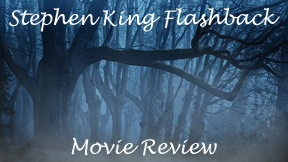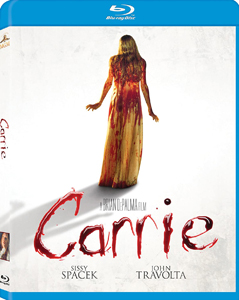Just as 1974’s “Carrie” was Stephen King’s first book, director Brian De Palma’s 1976 adaptation was filmgoers’ introduction to King. Unlike with “The Shining” four years later, the author approved of the “Carrie” adaptation. Lawrence D. Cohen faithfully adapts the plot and characters, but we do come away with a slightly different vibe.
Carrie carries us
In the book, we know everyone, because King bounces from brain to brain. In cinema, that’s not possible, so only Carrie White (Sissy Spacek) and Tommy Ross (William Katt) carry us through the action.
Everyone else is indifferent, acting out their proscribed high school clique roles. That’s not a criticism, as I find it to be an accurate take on teens. (What’s less accurate is the casting. Most of the “teens” are in their 20s and 30s. I think the prom crowd includes 40-somethings.)

“Carrie” (1976)
Director: Brian De Palma
Writers: Lawrence D. Cohen (screenplay), Stephen King (novel)
Stars: Sissy Spacek, Piper Laurie, Amy Irving
Even pig-blood prankster Billy (John Travolta) has no beef with Carrie: His two lines about her are “Who’s Carrie White?” and “That Carrie White is kind of cute.” He’s a pathetic idiot (a change from the alpha-male idiot of the book) controlled by his girlfriend, Chris (Nancy Allen). She is one of only two outright antagonists, along with Carrie’s mom Margaret (Piper Laurie).
The opening shower sequence where Carrie gets her first period and the gym class laughs at her makes for a shocking start by 1976 standards. Cinema was less than 20 years removed from the appearance of a toilet on screen being taboo.
“Psycho” challenged that standard, and that film’s DNA is all over “Carrie.” They share iconic horror shower scenes. When Carrie uses her telekinetic power in a quick burst, a Bernard Herrmann-style music sting plays, contrasting with the pleasantly sleepy main score. And the action is set at Bates High School, a change from King’s Ewen High.
Cold high school experience
After the opening, “Carrie” shifts to a lame after-school special feel where everyone is cold. Miss Collins (Betty Buckley) slaps around her students, which paints high school as generally unpleasant – not only from Carrie’s perspective.
When Collins holds a class-wide detention – with prom tickets dependent upon completion – I think “But what’s your punishment?” The teacher openly admits to initially reacting poorly to Carrie’s period, like her students do.
Spacek and Katt magnetically hold our attention. Carrie appears like an outcast only in a movie sense – she doesn’t wear makeup and hangs her hair over her face. When she wears makeup and puts her hair back, she’s pretty – and accepted by the prom-goers, whom Tommy rightly notes are a good bunch.
Still, Spacek is flexible to the film’s needs. Carrie is meek around her mom, yet iconically dangerous when unleashing her powers. We always like her and root for her. Tommy, meanwhile, is sweet and attendant to Carrie throughout the prom.

De Palma doesn’t make it clear if someone laughs at Carrie after she’s doused with pig blood or if she loses her mind with fear that they will laugh. If someone does laugh, it’s probably from a laugh-reaction that many teenagers have to stressful situations.
A stylish switch
Carrie’s makeover marks the film’s makeover from cheap-looking to cinematic. It hints at a dark sense of humor when it parallels a mural of pigs with the Last Supper mural in the Whites’ dining room. Seventies elements like zooms, split screens and practical special effects pepper the last half-hour.
In my head, I remembered Carrie destroying the whole town, but I mixed up “Carrie” with “First Blood.” She actually merely burns down the school. When she kills her mom, it’s in self-defense. She’s not all that far gone at the time of her death via collapsed house, so the tragedy isn’t as thick as in King’s book.
Carrie finds her freedom here more so in the book, where she’s in a perpetual trap between her mom and her classmates. She stands up for herself in the film. If she had gotten away with the prom killings (a case could be made that no survivor knows of Carrie’s ability), she might’ve had a chance at a stable life.
If we had followed Carrie into a sequel, it might’ve been neat to explore her lingering guilt over the prom events. One can imagine an alternate reality where “Carrie” becomes a series like “Friday the 13th.”
More ‘Psycho’ than slasher
In addition to only consisting of one film up until 1999 (when we meet Carrie’s relative who also has TK powers), “Carrie” is overlooked among Seventies and Eighties slashers because it’s not of a piece with them. It’s closer to “Psycho.”
“Carrie” is generally not scary, nor is it intended to be. Its famous “one last scare” is in fact the only jump scare. This scare finds Sue Snell (Amy Irving) having a nightmare about Carrie – De Palma’s adequate attempt at paralleling King’s dark moment where Sue is privy to Carrie’s experience of dying.
It’s no coincidence that I’ve gone this long without mentioning Sue; she’s even less of a character here than in the novel. In both versions, she’s passive, but in the book she’s an audience stand-in because we’re privy to her mix of sympathy and revulsion toward Carrie.
Outside of the “one last scare,” the film has moody moments, like when Margaret hides behind Carrie’s bedroom door. But no one in “Carrie” is mysterious enough to be scary. We either know the person thoroughly (the Whites, plus Tommy) or they fit a familiar high school role.
Of course, leaving wiggle room where “it’s not really a horror film” is how you get your horror film noticed by Oscar voters (Spacek and Laurie were both rightly nominated). “Carrie’s” scares are as superficially stylized as the prom theme, but that’s beside the point: De Palma delivers an excellent character portrait.
On Fridays, RFMC reviews a Stephen King book, adaptation or related work. Click here to visit our Stephen King Zone.

